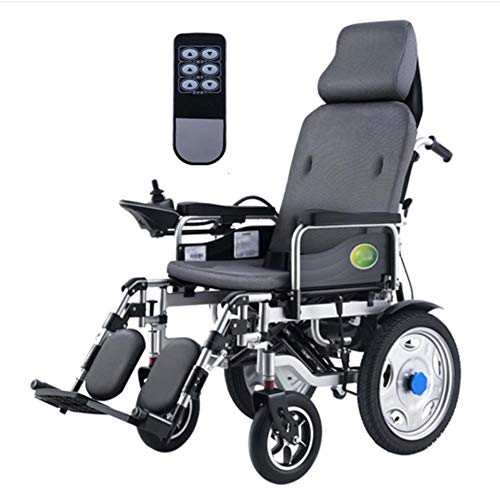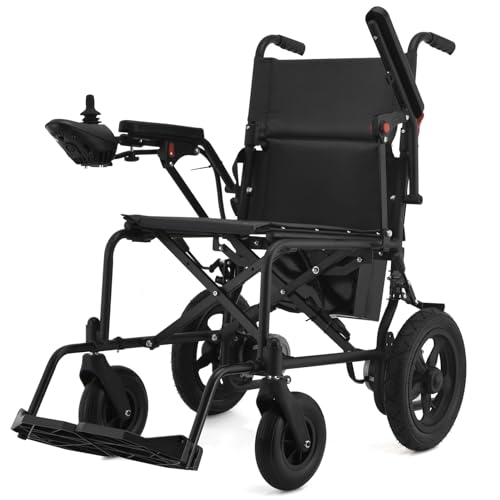15 Best Pinterest Boards Of All Time About Electric Wheelchair With Jo…
페이지 정보

본문
 Electric Wheelchair With Joystick
Electric Wheelchair With JoystickJoysticks in power wheelchairs can significantly increase the user's independence and make it easier to use. Standard joysticks might not be able to be able to accommodate the unique characteristics of hand dysfunction.
This study evaluated the effectiveness and satisfaction of customized power chairs for sale wheelchair Joysticks made with 3D printing. The test was conducted using modified power-mobility inside driving assessment (PIDA), National Aeronautics and Space Administration Task Load Index, and the Psychosocial Impact of Assistive Devices Scale.
Control
The control system of a power chair comprises two essential components which are the joystick as well as the electronics (also known as the controller). Standard joysticks are mounted on either the left or right side of the chair, while more complicated rehab chairs have swing-away mounts that permit the joystick to be moved to the middle of the seat.
The way in which a joystick will be mounted and used is essential to its performance for a user. If a person has a lot of tremors it is essential to design the joystick in a way that the movements do not cause the chair to move accidentally. Standard EPW joysticks utilize proportional input devices which respond to the deflection of the gimbal to control the chair's motion (similar to an electronic game controller or a car accelerator pedal).
There are a number of different alternative control options available for power wheelchairs that require minimal force to activate. These include switch controls, sip and puff controls as well as head array systems and chin control. Some of these controls require an additional interface to connect to the wheelchair. However, many of them are compatible with new joysticks that incorporate Bluetooth into the handles.
Some standard wheelchair joysticks have screens to display the condition of the system and provide feedback to the users. This is especially beneficial for those who are visually or cognitively impaired. Other advanced joysticks have the ability to control a variety of accessories like environmental controls, and even a tablet or TV.
Whatever technology is employed, a joystick will only be as effective if the user finds it easy to use. This is why it is important to consider the size and positioning of the joystick's buttons to ensure they are easily accessible. It is also essential to consider the joystick's sensitivity, which can be set to a variety of levels according to the specific needs of the user.
Comfort
A joystick-controlled powerchair has many advantages not accessible with a manual chair. They help reduce fatigue due to operational issues and are able to travel further than manual chairs. They can also be used in areas that are smaller and have more difficult terrain than a manual wheelchair such as uneven surfaces or slopes in the outdoors. With this added independence users can enjoy a freedom of movement that breathes new life into their lives and reminds users of the feeling to be independent once more.
A variety of different Cheap Power Chairs (Https://My-Mobility-Scooters10742.Scrappingwiki.Com/839775/What_S_Holding_Back_This_Heavy_Duty_Electric_Wheelchair_Industry) wheelchairs are offered with a wide range of options. The number of bells and whistles that a particular model features will depend on what the user wants and requires. The most commonly used features include:
Controls that can be customized on an electric small wheelchair wheelchair with the joystick is a possibility to satisfy the individual's needs. This includes the type of knob or handle, as well as the ball or the manner in which it is mounted. Joysticks are usually located on the armrest of the driver's chair, while others are placed in the front or back of the seat to make it easier for the attendants to reach. Some joysticks can be mounted on the side of the seat for those who have limited shoulder mobility or a weakness in their muscles.
Other features can be more customized like the design and size of the joystick screen. Some models are backlit or have a color that is more accessible for those with low vision. Some models also have additional modes that provide visual or audio cues for navigation. Other models can include odometers, clocks, and indicators of battery charge.
The ability of a joystick to maneuver within a narrow turning radius is also crucial. The best models will have a smaller turning radius, which makes it easier to navigate obstacles and narrow spaces such as hallways. This tight turning radius allows for easier navigation in public areas and stores. This tight turning radius is particularly beneficial for those with mobility issues such as cerebral palsy, multiple sclerosis ALS Huntington's disease, spinal cord injury, or brainstem stroke.
Safety
Power wheelchairs are designed with safety in mind. They have robust brake systems that can limit the speed as quickly as the consumer presses the joystick control. The chairs also come with anti-tip rear wheels that prevent the chair from tipping forward.
The most commonly used type of joystick is a proportional control which is similar to car accelerator pedals and video game controllers in that the more the joystick is moved away from the center the faster the wheelchair moves. Joysticks that are proportional require a strong hand and good proprioception to operate. Joysticks that are standard are mounted on the armrest. However there are several of special controls that put the controls on the middle or side of the seat.
Certain people might not have the strength to deflect a joystick handle, even with special rigging. Some people with spasticity may have issues because their muscles can become stiff or atrophy. In these cases it is possible to use a head control device that converts the movement of the consumer's head into the required instruction for the wheelchair could be a better option.
The size and position of the joystick's buttons is another thing to consider. If the buttons are too far in the front or difficult to reach, they could interfere with the position of the user, and cause stress on the hands. If the joystick is placed too far back, it could be difficult to maneuver the chair or turn the wheels.
The seatbelt must be fastened on an electric wheelchair. The most powerful wheelchairs can reach speeds up to 8 mph, and an unfastened seatbelt can lead to serious injuries or death. Batteries should be charged regularly and, ideally, every night. This will ensure they have longer life and keep their efficiency. You should also have your chair regularly maintained to ensure that all terrain electric wheelchair uk components are operating properly.
Accessories
Joysticks are an essential component of power wheelchairs. They can be upgraded by a variety of accessories. These range from simple switches to more advanced interfaces that connect to communication devices or even external environmental control units. Higher-end power wheelchairs will often include a variety of controller components that can satisfy the needs of different clients. A non-expandable control will only accept a proportional stick as an input device while an expandable one can also take sip and puff control, specialty switches, and head array systems. Some of the more advanced controllers are capable of operating up to two power seating actuators which can adjust the angle and position of the seat.
The most basic type of joystick used in the clinic is an inverse control, often referred to as a movement sensing joystick. This type of joystick like accelerator pedals for cars and video game controllers, responds to the force exerted on the stick by increasing its output (i.e. The speed of the wheelchair increases as the stick moves away from the center. This requires a good deal of dexterity and a healthy sense of proprioception for efficient use.
The technology of today can compensate for small variations in amplitude when EPW driving. However, it cannot detect and adjust for many more extreme unintentional motions like those that cause larger amplitude tremors, or involuntary movements that are not caused by conscious intent, such as athetosis.
Most wheelchairs have a number of parameters that can be programmed and customized, usually with the help of a medical professional. These parameters include changing the torque generated by the motor, changing the speed at which the chair moves and setting the dead zone that is the area within which the EPW is unable to produce an output. Some controllers allow the clinician to save backup programs. This is helpful in an emergency or when a patient's symptoms alter.

- 이전글Critical essay on patrick henry 24.11.10
- 다음글블랙툰 막힘 ※여기여※ 19링크모음 야동사이트 누누티비 24.11.10
댓글목록
등록된 댓글이 없습니다.